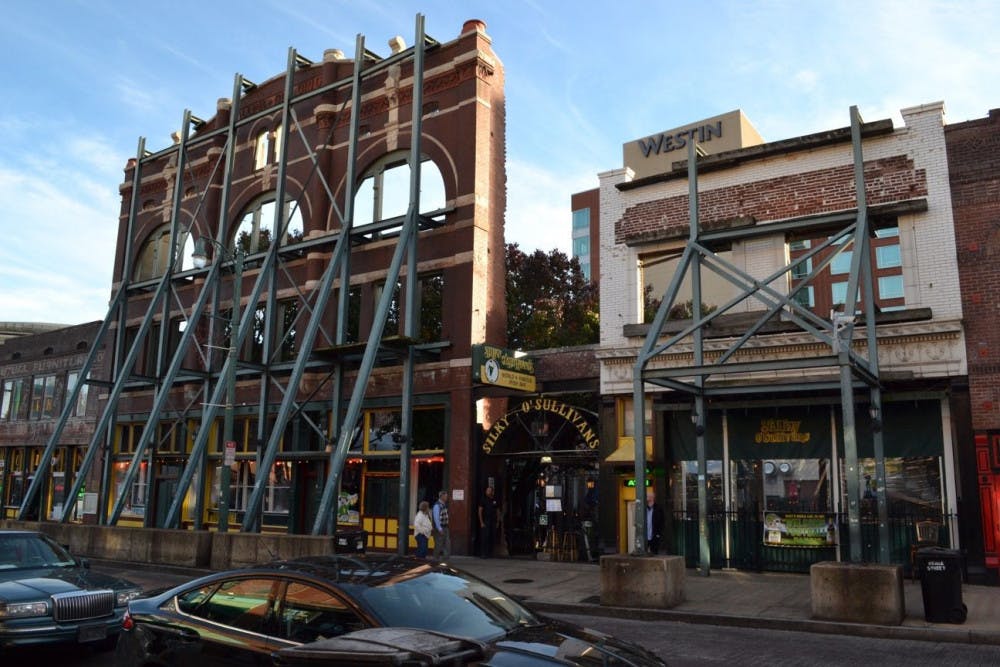
Beale Street has remained a popular Memphis destination for tourists and locals alike for over a hundred years.
Late nights in Downtown Memphis draw hundreds of people under the neon signs that light up one of the most popular tourist destinations in Tennessee Beale Street, also known as the Home of Blues and the Birth Place of Rock ‘n Roll.
Despite its historic roots in African American culture, only about 20 percent of the businesses on Beale are owned by African Americans.
Â
“It is pathetic when you think about it in the early days the whole damn city was black,â€Â At the same time, Memphis’ population is 63 percent black and 29 percent white. - Lew WinstonÂ
Â
“It is pathetic when you think about it in the early days the whole damn city was black,†said Lew Winston, the owner of the Blew Note Bar & Grill. “They let one owner get too many businesses down here. It should be one business for one person that would have allowed for more black businesses.â€
Only five of the 24 businesses on Beale’s busiest section, between Second and Fourth Street, are owned by African Americans, and only three are owned by women.
Lew’s Blew Note Bar & Grill, Memphis Music, Strange Cargo, and Eel Etc. Fashions represent the only black owned businesses on Beale Street, while Dyers, Alfreds, and Silky O’ Sullivan’s represent the only businesses owned by women.
“We may not be many, but we are mighty,†Joellyn Sullivan, the owner of Silky O’ Sullivan’s, said about the minority and female run businesses on the street.
According to Ty Agee, who has been the president of the Beale Street Merchants Association for six years, the owner of Miss Polly’s Soul City Café, Beale Street is the soul and the backbone of down- town, and it’s got a life and a personality of its own. Agee said the businesses on
Beale Street are owned by many men and women of different ethnicities according to Agee.
“There is diversity here,†he added.
Two hundred years before Beale Street became the popular tourist site that it is today, it was a place for free or runaway slaves to freely stay or mingle after the civil war.
Freed slaves and sharecroppers fled their farms for Memphis bringing blues, gospel, and country with them in search of economic opportunities.Irish, Italians, Germans, and Jews also made their way towards Memphis.
“The combination of immigration from the Delta and emigration from Europe all mixed into what made Beale Street the flavorful community it was at the turn of the last century,†said Jimmy Ogle, a Memphis historian, University of Memphis graduate, and the chairman of the Shelby County Public Records Commission.
During the 1950s most of the businesses on Beale Street were owned mostly by white
emigrants,while the patrons were majority African Americans.
More than 60 years later, the business on Beale Street have changed from hardware stores to bars and clubs, but ownership has not.
“Beale Street during the middle of the 20th century grew up as the main street of Black Memphis, the main street of Black America,†said Ogle. “The important thing was the face of Beale Street was black.â€
Oncesegregationended, African Americans left Beale Street to shop at stores that they could not before, such as Goldsmiths.
As African Americans began to shop elsewhere. Beale Street was fenced off, businesses on Beale Street were boarded up, and began to decay. The only building that remained open was A. Schwab, and customers had to enter from the alley.
By 1979 there were more peo- ple living in jail in downtown Memphis than residentially, with 500 living downtown and 1000 in jail.
According to Ogle,the Memphis city leaders’ mindset was to build a bigger jail.
In 1983, Beale Street par- tially opened and businesses began to breathe life back into the street where Elvis Presley, Danny Thomas, B.B. King, Tina Turner, and other had walked and performed.
“Now there are 23,000 people living downtown, 115 restaurants, 15 museums, and Beale Street is the number one revenue gross- ing tourist attraction in Tennessee with all the clubs, and music, and selling a lot of booze,†Ogle said.
Downtown Memphis continues to grow and expand, but the business ownership on Beale Street still reflects that of the 1950s with less than half of the businesses on Beale Street accurately represent- ing the population in Memphis.






